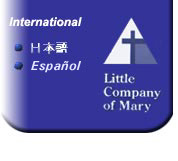
| Little Company of Mary Hospital Among the First in the United States to Offer New, Safer Heart Bypass Surgery Technique |
Posted: July 9, 2001 |
Torrance, CA�Little Company of Mary Hospital is among the first hospitals in the United States to offer a new and potentially safer form of cardiac bypass surgery for patients.
This innovative procedure lessens the need for surgeons to use needle and thread to sew new blood vessels into patients during coronary bypass operations . Instead, a new product recently approved for use by the Food and Drug Administration utilizes a device that instantly connects blood vessels to the aorta. This is how it works: the device, which resembles a long-handled screwdriver, is loaded with a vein and is inserted into a small hole that has been cut into the aorta. The physician pushes a button on the device which releases a tiny web of wires that unfolds to form a star-shaped rivet. In less than 10 seconds, the vein is attached to the aorta mechanically. Using the traditional method of needle and thread takes surgeons between three and five minutes. The advantages for the patient include less time in the operating room, less time on the heart-lung machine, less invasive surgery and a corresponding reduction in the potential for serious side effects, especially blood clots and stroke, resulting from surgery.
Currently, the procedure is restricted to a very specific form of bypass surgery utilizing saphenous veins---replacement blood vessels that are harvested from a patient�s leg. The device is used to attach the proximal end of the vessel to the aorta. Surgeons who use the device will still use a needle and thread to stitch the other end of the vein to an artery on the heart. Research is ongoing to design a device that will allow surgeons to do away with the traditional needle and thread method entirely.
Doctor James D. Hall, a Little Company of Mary Hospital cardiovascular surgeon and the facility�s first physician to be trained in the new procedure, is a major proponent of its use. �This new procedure should lessen the amount of time the aorta is clamped and may prevent the need to clamp the aorta," said Dr. Hall. "What makes it so promising and exciting for patients is that it ultimately reduces the risk for stroke and other serious side effects that may be associated with clamping the aorta."
According to Mark Costa, Chief Operating Officer of Little Company of Mary,
� We are tremendously excited to be able to offer this cutting edge advancement in heart bypass surgery at Little Company of Mary Hospital. Little Company of Mary has always been in the forefront of cardiac health. In 1974, we were one of the first area hospitals to open a cardiac catheterization lab for the diagnosis and treatment of cardiovascular disease. In 1978, we were the first area hospital to offer Computer Assisted Tomography (CAT) scan technology. The physicians and staff that make up our Heart Center look forward to continuing our tradition of innovative care to use this new technology for the benefit of our patients.� |
|
|












